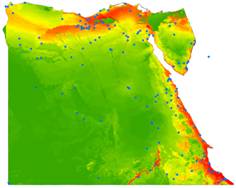 Conservation
ecology Conservation
ecology
It
is impossible
to study biodiversity scientifically without becoming interested in its
conservation. Research has an important role to play in helping to
understand
the ecological basis of human induced threats to biodiversity. We are
also
interested in using such approaches to help manage and mitigate threats
to
species and habitats.
.
.
 In order to
conserve biodiversity, we must have some idea
where it’s found. However, many parts of the world,
especially in the tropics,
have been very poorly surveyed for species. This has led conservation
biologists to attempt to predict the distributions of species, using
known
occurrences of species and maps of climate variables, such as climate,
vegetation, habitat and topography. In order to
conserve biodiversity, we must have some idea
where it’s found. However, many parts of the world,
especially in the tropics,
have been very poorly surveyed for species. This has led conservation
biologists to attempt to predict the distributions of species, using
known
occurrences of species and maps of climate variables, such as climate,
vegetation, habitat and topography.
Francis Gilbert and Samy Zalat coordinated BioMAP
Egypt,
a project that has been collecting sightings of Egyptian species from
museum
records and from the literature, compiling them into an electronic
database.
This database now holds over half a million records of species from
diverse
taxonomic groups.
In Nottingham,
Francis
Gilbert, Tom Reader
and Tim Newbold have
been using these data to produce
predictions of the distributions of Egyptian species. The map above
shows the predicted distribution of the Dorcas Gazelle (Gazella dorcas);
warm colours show areas of high predicted probaility, while cooler
colours are areas of low predicted probability. We have been testing
which variables produce the most accurate predictions and whether
certain
species are better modelled than others. We have also been making
predictions
of spatial patterns of species richness, assessing whether Egypt’s
protected areas provide good coverage of biodiversity.
We have also collaborated with Stuart Ball of the JNCC, attempting to
predict the impact that climate change will have on the
distribution of British hoverfly species.
We believe
that ecological research has an important role to play in identifying
threats
to species and habitats and evaluating methods used to counter such
threats.
Conservation problems are often identified when basic monitoring
programmes
detect large declines in the range or abundance of a species.
Unfortunately the
causes of such patterns are often not obvious. However careful
investigation
using long term datasets, autecological studies and experimental
application of
remediation techniques may reveal the cause of the problem and suggest
possible
solutions.

In collaboration
with the RSPB, Andrew MacColl
and Finn Stewart studied the British willow tit Poecile
montanus kleinschmidti. The willow tit is currently one of Britain and Europe’s
most rapidly declining bird species. The very large scale nature of the
decline
in this species suggests that a climatic factor or some human activity
may be
its cause. Finn's PhD used long term datasets on the occurrence of the
bird and
the quality of its woodland habitat, as well as field studies to
identify the
cause of the decline and to inform future
management of the
species and its habitat.
Willow tit (Poecile
montanus kleinschmidti) - Dr. Katherine Clark ©
|
 Conservation
ecology
Conservation
ecology In order to
conserve biodiversity, we must have some idea
where it’s found. However, many parts of the world,
especially in the tropics,
have been very poorly surveyed for species. This has led conservation
biologists to attempt to predict the distributions of species, using
known
occurrences of species and maps of climate variables, such as climate,
vegetation, habitat and topography.
In order to
conserve biodiversity, we must have some idea
where it’s found. However, many parts of the world,
especially in the tropics,
have been very poorly surveyed for species. This has led conservation
biologists to attempt to predict the distributions of species, using
known
occurrences of species and maps of climate variables, such as climate,
vegetation, habitat and topography.